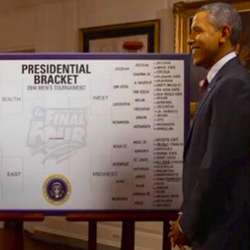
In recent decades, the U.S. National Collegiate Athletic Association (NCAA) College Basketball Championship–a.k.a. March Madness–has grown into a near-national obsession in the U.S. Fans root for their alma maters and cheer on their favorite athletes; the Internet and social media light up with posts. Yet, as the tournament has gained in popularity and TV ratings have spiked, another phenomenon has taken root: betting on brackets.
The U.S. Federal Bureau of Investigation reports $2.5 billion is illegally wagered on March Madness each year. Remarkably, the popularity of playing the odds and selecting a winner nearly overshadowed the actual basketball games, especially since Quicken Loans and Warren Buffet offered a $1-billion prize to anyone who could produce a perfect bracket for this year’s tournament, which has random odds of one in 9,223,372,036,854,775,808 and has never before occurred.
Says Sheldon Jacobson, professor of computer science at the University of Illinois at Urbana-Champaign, "The event has become a national frenzy and the focus on picking winners from the 68 teams has become a sport in itself." Even President Obama was not immune to the frenzy, filling out his bracket during an interview on cable sports network ESPN.
Not surprisingly, computers and algorithms play a growing role in sports betting. Participants looking to gain any advantage possible are tapping into new software and methods to improve their odds. At the same time, computer scientists are probing the odds and outcomes surrounding March Madness and other sporting events to gain a better overall understanding of probability models.
By the Numbers
The quest to beat the odds and build a better statistical system is nothing new. With the advent of computers, however, big data and increasingly sophisticated analytics have turned sports wagering upside down. For example, Tim Chartier, an associate professor of mathematics and computer science at Davidson College, began predicting college basketball results in 2009. He landed in the 97th percentile among four million ESPN participants that first year in analyzing the NCAA tournament; the following year, his group pushed that figure up to 99.9 percent.
"Considering the number of upsets that occur, it’s very difficult to pick the tournament successfully," Chartier says. In fact, in the history of the ESPN contest, which began in 1998, none of the participants (there were nearly 30 million this year) has ever come close to picking a perfect bracket.
Chartier examines wins, the strength of the team’s schedule, current momentum, how the team performs at road games, whether it achieves extended winning streaks, and whether it wins close games. At his website, March MATHness, visitors can choose different approaches, parameters, and weightings, and view how they impact a team’s odds of capturing a title.
Joel Sokol is another entrant in the March Madness derby. The associate professor at the Georgia Institute of Technology’s School of Industrial and Systems Engineering, working with with some of his colleagues, has developed a system called the Logistic Regression/Markov Chain (LRMC) college basketball ranking system, which has identified three champions over the last seven years. The combined statistical and operational research model taps into winning parentage, margin of victory, and where games are played. However, Sokol acknowledges that the best models may be those no one is aware of; "anyone who creates something that works really well probably won’t publish their work. They will use it or sell it," he says.
Jacobson, who makes it clear he is not a gambler, has examined how top-seeded teams perform and the statistical differences they displayed. He has run tens of thousands of bracket results from 29 past tournaments through the computer, and has picked as many as 58 of 63 games correctly in a single tournament. "We found that in the first three rounds, there is significant statistical difference. As the tournament moves into the Elite 8 and beyond, the differences wane and the seeds become statistically irrelevant."
Probabilities Matter
Computer scientists and mathematicians are plugging knowledge gained from the NCAA tournament, Super Bowl, baseball, jai alai, World Cup Soccer, and other areas into their models. "The NCAA basketball tournament is essentially a candy store for the analytically inclined," Jacobson states. "The tournament is a test-bed for analysis. The same methods can be used to address real-world problems."
One of the most promising areas for these methods, he says, is aviation security, which uses similar probabilistic principles and models. Chartier says probability methods gleaned from sports can also be used to build better algorithms for social media, online travel, and even restaurant rankings.
Sokol says the same methods could eventually be used to better understand talent in sports and other areas. By more effectively evaluating areas such as physiology and psychology, researchers could identify factors involved with day-to-day variations in performance, which is currently viewed as a random effect. The ability to "watch players in pregame warm-ups and judge how they will play that day" could lead to last-minute changes in lineups while providing gamblers with much better information than early bettors.
To be sure, the lure of winning the office pool or "beating the house" in the sports book of a casino is nothing less than alluring. According to the American Gaming Association, only about 1 percent of all sports wagering in the U.S. takes place legally in Las Vegas; as much as $380 billion a year occurs illegally.
Sokol says it is exceptionally difficult to try to beat the house, no matter the method. "The oddsmakers already use sophisticated algorithms and statistical methods very effectively," he says. "It’s extremely difficult to come up with a method that will beat them."
Samuel Greengard is an author and journalist based in West Linn, OR.



Join the Discussion (0)
Become a Member or Sign In to Post a Comment